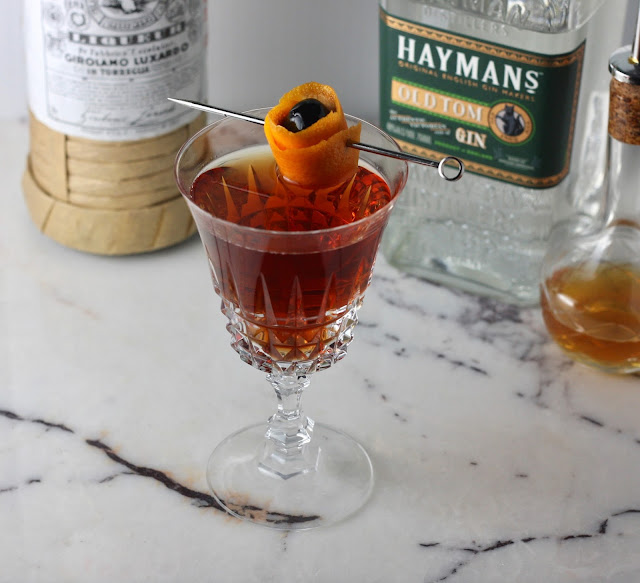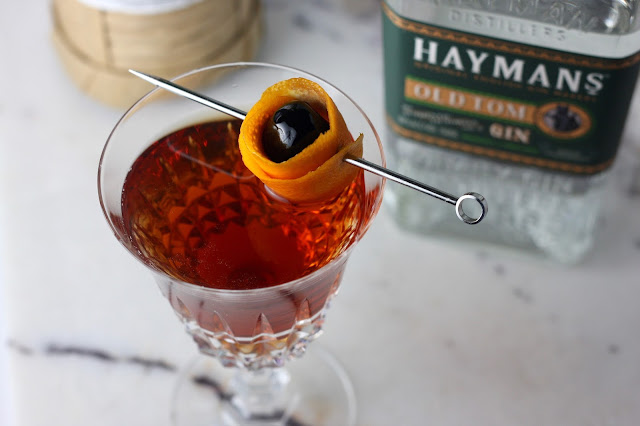It's Valentine's Day again, and you know what that means: it's time for red and pink cocktails. Just about every cocktail site I can find has some sort of round-up of romantic drinks in these hues this week. And luckily for those who will be making and drinking them, it's much easier to make a decent red or pink cocktail than one of any other color (except maybe brown). There are tons of fantastic ingredients that will lend a reddish hue to your drink: Campari, Aperol, Peychaud's bitters, grenadine, blood orange, raspberry... the list goes on. Other holidays - say, St. Patrick's Day, for instance - don't have this advantage. So I'm hopping on board and featuring one of the most classic pink cocktails of all time: the Pink Lady.
The Pink Lady has gotten something of a bad rap over the years, for reasons that I'll explain below. You might look at it and think it's a creamy, saccharine concoction, but that couldn't be further from the truth. It's actually not sweet at all, but quite tart. Egg white gives it a silky mouthfeel and a beautiful layer of foam. Grenadine lightly sweetens it and gives the drink its lovely pink hue. This is respectable classic, held back by its color and its name. But Valentine's Day is clearly the Pink Lady's time to shine.
About that egg white: I know it might be making you nervous. I used to avoid cocktails made with egg whites like the plague. I thought they gave drinks a bit of an odor that really turned me off. But if you use fresh egg whites and - I think this is key - not too
much egg white, it should only impart texture to your drink, not flavor or scent. Most recipes call for a single egg white, but eggs have gotten much larger since pre-Prohibition cocktails like the Pink Lady were created. Half of a modern-day egg white is plenty.
Since I got over my aversion to egg white cocktails, another hurdle prevented me from making them: I could never quite get that lovely layer of foam. I'm still not sure how some people seem to do it so effortlessly. For me it took every trick in the book, but eventually I found a technique that seems to work pretty consistently. And you can do it too! See below for my tips.
History: The origin of the Pink Lady seems to have been truly and entirely forgotten. If you know otherwise, please comment and set me straight. But I can't find any real history on it. It seems clear that it was around before Prohibition, and that it's probably related to the Clover Club, another pink gin drink with egg white that uses raspberry syrup instead of grenadine and omits the Applejack. But that's about it.
The period of the Pink Lady's history that
is well known is its post-Prohibition reputation as the first "girly" drink. Even though it's actually fairly strong and not that sweet, its delicate hue and ladylike name made it the stereotypical drink of girls who didn't really drink - they'd order one because it looked or sounded nice. In his 1951
The Bartender Book, Jack Townsend wrote that the woman who drinks a Pink Lady is "that nice little girl who works in files, who's always courteous but always seems so timid. She's the one who sort of reminds you of your aunt, the quiet one." He describes how she only drinks once or twice a year, and selects the Pink Lady because "she has seen the decorative and innocuous-appearing pink-and-white amalgamation passing on a waiter's tray and decided, 'Hmmm, that couldn't do me any harm.'"
Putting aside the unsurprisingly chauvinistic description of the "nice little girl," I have to say I feel immediate sympathy for the Pink Lady drinkers of the 1950's. Before I knew anything about cocktails, I was pretty intimidated by ordering at a bar. I would definitely select something with an appealing name, or point at the pretty drink the bartender was making for someone else and say I wanted one of those. I imagine we all have. So I say there's no shame in drinking a Pink Lady.
Still, Townsend's description cemented the Pink Lady's reputation as a girly drink for girls who don't drink, and this led to a definite decline in popularity. I imagine that the inclusion of grenadine and egg white, two ingredients that are so easy to get wrong, did not help. These days the Pink Lady can be found on cocktail menus once again, and finally commands a bit of the respect that she deserves.
Pink Lady
1 1/2 oz. gin
1/2 oz.
applejack
3/4 oz. lemon juice
1/2 egg white (1/2 - 3/4 oz.)
2 dashes (1/4 tsp.)
grenadine
Basic instructions: combine all ingredients in a shaker with ice and shake very well. Strain into a coupe glass and garnish with edible flowers or a brandied cherry.
To really master that foam: I've had the best success with the "reverse dry shake" method. A dry shake is when you shake the cocktail without ice first. However, when you do this with a warm cocktail, I often find that the shaker doesn't make a nice seal and tends to leak, and the foam doesn't form as well during that second shake with ice. So for a reverse dry shake, combine all your ingredients in a shaker with ice (I like a
Boston shaker rather than a
cobbler shaker, as there's more distance for everything to go with each shake) and shake very well until it's chilled. Then strain the cocktail and dump the ice. You'll probably see some foam, but nothing close to the perfect, frothy layer you're aiming for. So return the cocktail to the shaker and do another, longer round of shaking without the ice. For best results, throw in a
blender ball or spring to help whip the egg. (I literally use one of
these.) Shake it for at least 60 seconds. And I mean count with full Mississippis - 60 seconds is longer than you think, especially when your arms are getting tired. Strain into a coupe glass, open pouring the last bit to get the final, thick drops of foam.
Recipe adapted from Vintage Spirits and Forgotten Cocktails.
















